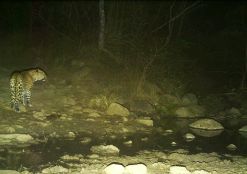
Big Five cat moves into new reserve
The revamped UmPhafa Private Nature Reserve in KwaZulu-Natal is the result of an international conservation partnership, and has just seen its first leopard move into the area. Previous mismanagement in the park led to the eradication of a number of species. But since 2005 the park has been a project of Action for the Wild, the […]

The revamped UmPhafa Private Nature Reserve in KwaZulu-Natal is the result of an international conservation partnership, and has just seen its first leopard move into the area.

Previous mismanagement in the park led to the eradication of a number of species. But since 2005 the park has been a project of Action for the Wild, the charity arm of Colchester Zoo in the UK, who’ve worked with local authorities and communities to breathe new life into the land.
The 5 000ha UmPhafa is made up of three farms, Gevonden, Geluk and Vertrek, and it was overgrazing during its farm stage that led to soil erosion, invasion by alien vegetation, and other degradation.
When Colchester took over the three farms were joined and fenced off, and since then research facilities and hides have been built, and 13 species have been re-introduced.
UmPhafa is home to several antelope species, including kudu, impala and mountain reedbuck. Black-backed jackal also occurs naturally.
Thanks to dedicated conservation tactics, today a wealth of species live in the park, including giraffe, white rhino, zebra, and blue wildebeest, as well as red hartebeest, waterbuck, common reedbuck, and nyala.
The presence of these stout antelope, which are a normal part of the leopard’s diet, means that the reserve would be a suitable habitat for the shy cats.
Besides replenishing the fauna and flora, UmPhafa management are also involved in research projects, including behavioural studies of bushpig and white rhino; control of alien plants through natural means such as insects; and assessing the significance of small mammal populations on carnivore numbers.
The reserve employs 13 people from local communities in various capacities. Some of them have been trained in wildlife management and game ranging techniques, equipping them with valuable skills. Reserve staff also work with local schools, giving wildlife education and helping to raise funds for new equipment or refurbishment of existing facilities.
Big cats move in
Now, with the first African leopard (Panthera pardus pardus) recently spotted in the reserve, researchers will be able to monitor and study the animal’s population density in the area.
Signs of the leopard’s presence had been seen since December 2010, when tracks and hair confirmed that it was wandering around. Livestock killings provided further evidence.
But it remained elusive for eight months, until cameras, set up on the reserve, caught it on film. Scents trails and bait were laid to attract the animal to the cameras, and finally in August the nocturnal prowler was photographed on Geluk.
Because leopards generally choose to stay away from livestock, thereby avoiding contact with humans, it was first thought that UmPhafa’s leopard was old. As its hunting abilities decrease with age, an elderly cat must seek easier prey.
It was also thought that, because there were no signs of natural kills, the leopard was feeding on smaller animals that could be consumed overnight, leaving no evidence for park staff.
Saving the leopard
With fears that loss of natural habitat and fragmentation of populations will soon result in the leopard moving from its near threatened status on the Red List of the International Union for the Conservation of Nature, to vulnerable, staff hope that the cat will find a haven at UmPhafa.
Any of South Africa’s Big Five – lion, elephant, buffalo, rhino, and leopard – are major tourist attractions, but because the leopard is so particularly elusive, many visitors do not get the opportunity to see or photograph this animal.
Not only does it drag its kill into trees, where it can comfortably eat and sleep, and also prevent scavengers from making off with its food, but the leopard is nocturnal.
There are more than 20 different types of leopard, each with its own special trait. The clouded leopard has the longest canines of all the cats, whereas the snow leopard lives in the Himalayas and easily negotiates difficult terrain and climate conditions.
The black leopard is usually called a black panther, as its dark fur makes the spots hard to see – but the “black panther” itself does not exist, and the term is also applied to South America’s jaguar. The Amur leopard, native to Russian mountains, is one of the rarest animals in the world and is listed as critically endangered.
Source: www.mediaclubsouthafrica.com
